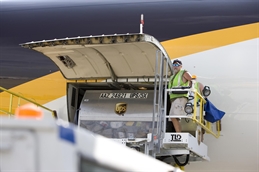
UPS has sent out some bullish signals lately. In January, the integrator expanded its Worldwide Express Freight service in 12 new origin and nine new destination countries. This move put the company’s offering designed for urgent, time-sensitive and high-value international heavyweight shipments into 50 origin and 51 destination countries and territories throughout the world. In the Asia-Pacific region, UPS Worldwide Express Freight has been extended in Indonesia, New Zealand and Vietnam.
UPS describes the service as “ideal for product launches, inventory shortages or equipment failure replacement parts.” It is guaranteed and day-definite door-to-door product. Transit times range from overnight for some intra-Asian sectors to three days to Europe and the Americas.
The expansion of a higher-yield product indicates resurgent demand for faster delivery options, after years of belt-tightening that saw shippers abandon premium transportation services for cheaper alternatives. Air cargo executives have been stressing a clear improvement of their industry’s fortunes.
“The discovery is for real,” said Shawn McWhorter, president for the Americas of Nippon Cargo Airlines. Demand improved steadily throughout 2013 and 2014 and early bookings for this year suggest that the momentum will hold, he said.
Statistics from the International Air Transport Association (IATA), the global airline body, show a 5.4% rise in cargo traffic in October, which brought the industry finally back to levels last seen in 2010.
Growth varied considerably from region to region, though. Airlines based in the Asia-Pacific region clocked up 6.7% growth in October, while their counterparts from North America and Europe saw improvements of 3.1% and 1.4% respectively.
Among Asian carriers the mood is upbeat on intra-regional business – thanks to regional shifts in production and rising consumer demand – and on the transpacific sector, where demand from US consumers is expected to continue its growth pattern of recent months.
“I am still fairly optimistic about the strength of the US economy – the reduced gas prices should put dollars in consumers’ pockets,” remarked James Woodrow, director of cargo at Cathay Pacific.
Executives at UPS as well as FedEx anticipate a boost in demand from low inventory levels at US retailers. According to the former, robust consumer spending in the fourth quarter has depleted inventories and the replenishment drive in preparation for spring launches should generate lively demand for both air and ocean carriers.
During an earnings call following the release of FedEx’s second quarter results, company president and chairman Fred Smith noted that the problems at US West Coast ports pushed some traffic the integrator’s way but that they also produced low inventory levels in some cases. This should lead to increased restocking activity in the first quarter, he reckoned.
Executives at IATA have commented on improved demand for air cargo in recent months, but they harbour some concerns all the same and have cautioned that the current cyclical upturn would not resolve structural problems that cast a shadow over the industry’s viability. According to IATA chief economist Brian Pearce, the economic cycle was weak, notwithstanding increased volumes at this point. Uneven growth, with weakness and uncertainty in Europe contrasting with a recovery in the US, further undermine the airlines’ situation, he added.
Further cause for concern lies in the new capacity that is about to be unleashed in the months ahead, Pearce warned, pointing to large numbers of widebody passenger aircraft, as well as freighters, that are poised to enter the market in 2015.
Glynn Hughes, IATA’s global head of cargo, warned at last year’s International Air Cargo Forum that the air cargo industry needed to address evolving shipper demands to avoid a slide into irrelevance as cargo traditionally moved by air has been shifted over to surface transportation modes. This called for pronounced improvements in performance. IATA has been championing initiatives to improve processes like e-freight and called on the industry to cut 48 hours out of average transit times.
By Ian Putzger
Air Freight Correspondent | Toronto



